Authors: Mitalis
Nine Keys to a Successful Marketing Plan
- Quantified Goals
- Compatibility of Professional and Personal Goals
- Limited Number of Reasonable Goals
Authors: Mitalis
Nine Keys to a Successful Marketing Plan
Authors: Bryce Whitty
If a large part of your client base is residential then you may have been asked “shop around” on a clients behalf. The client knows they need to purchase something but want to do it alone because they want to make sure they dont purchase the wrong one or get ripped off. This usually occurs in two ways:
While this sounds like an easy way to make money, how do you charge? Do you charge for your time or do you place a markup on the product?
Well, there is a right way and a wrong way to go about this and if you get it wrong, you can end up wasting a lot of time or upsetting your customer.
The client will generally let you know whether they want to purchase through you or purchase from another business but you may have to ask. Here is what to do in each situation:
If the client wants to purchase the product through you, then you simply to treat this like you would with any other stock you carry, where the markup makes it worth your time. You do the research for your client, you buy the product through your business and place your markup on it that is appropriate for the amount of time you spent, and the client never knows who your suppler was.
If the client has another business in mind like BestBuy or Newegg, you need to charge based on your time rather than have a markup. Marking up a product is difficult to do in this situation without looking like like you picked a price out of thin air.
For example, which way sounds sounds more legitimate?
The first looks like you plucked a price out of thin air, the second sounds fair enough.
The best way to go about this is to shop with them either physically or using remote support software to shop with them online. This way they know they are taking up your time and that you need to charge for it.
Otherwise, if you tell them what to purchase after you put in the time researching for them, it is possible that they will just go buy it from a Big Box store and circumvent you entirely. There was a topic similar to this in the Technibble forums recently where Lisa from Call That Girl said: “We tell the clients to pay us for our shopping time. Remote time with me is our normal rates, $59-$79 to shop online together, or they can take my lead tech to Microcenter and he’s $125 an hour. We save people money by shopping with them.”
Following the simple guideline above, this should help prevent you from getting stung when shopping on behalf of your clients.
© Technibble – A Resource for Computer Technicians to start or improve their Computer Business
To get started with your own computer business, check out our Computer Business Kit.
Authors: Bryce Whitty
DropboxPortableAHK is a portable version of Dropbox made possible with a small application written in the scripting language AutoHotKey. While this is not a repair tool, there are a huge amount of technicians who make use of Dropbox to access files while onsite. This application allows you to run Dropbox from a USB drive and sync files that are contained on your Dropbox account. Other than the obvious benefit of being able to access your Dropbox files on your USB key, it doesn’t leave any files on your clients computers and can be run when you don’t have administrator permissions.
The setup application itself has some nice features such as allowing you to create an autorun.inf file to automatically start software on your USB drive, import the Dropbox folder and optionally make it so the application syncs all files before you exit Dropbox.
One caveat is that this software uses Dropbox version 1.1.45 which is an older version. The reason why they use an older version is because newer versions encrypt their configuration files which prevents this application from changing the Dropbox path to your USB drive.
To install DropboxPortableAHK, download and extract the zip file to your USB key, run the DropboxPortableAHK.exe file and follow the prompts.

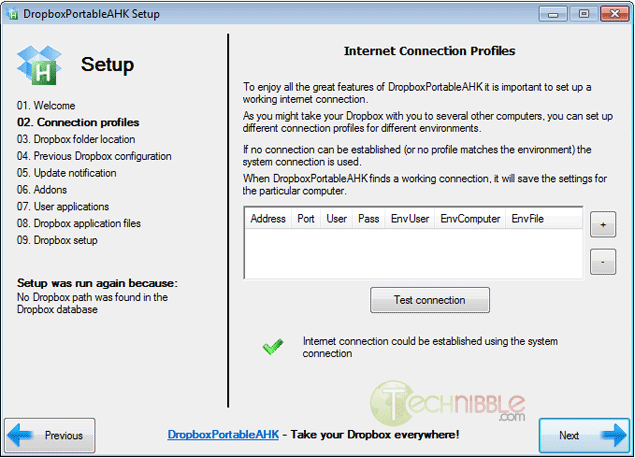
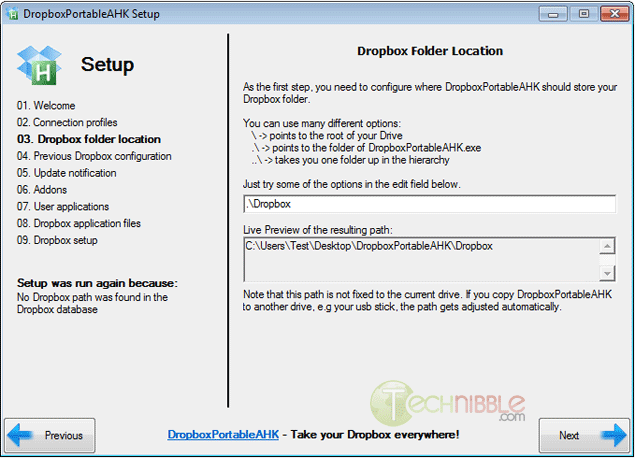
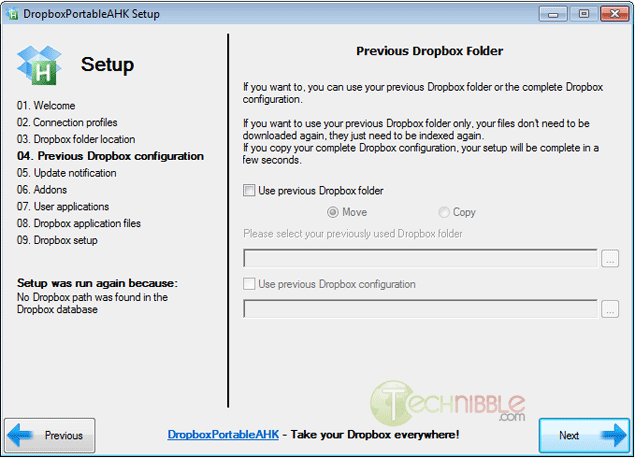


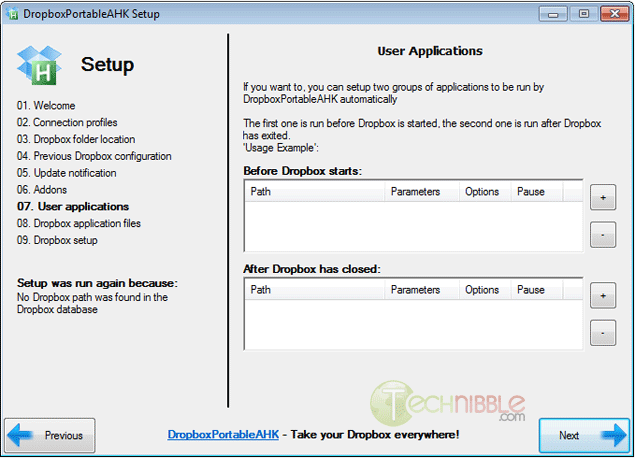

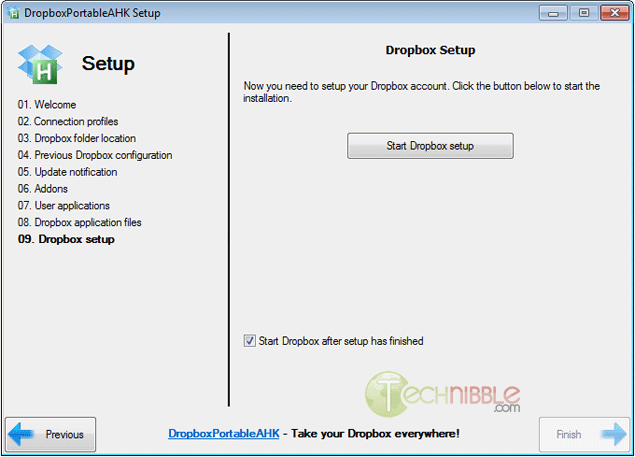
Download from Official Site – 1.4mb
© Technibble – A Resource for Computer Technicians to start or improve their Computer Business
To get started with your own computer business, check out our Computer Business Kit.
 1 1
1 1
Authors: Bryce Whitty
This post is a little different than our usual lineup as I would like to talk about the Technibble site itself.
Back in 2006 Technibble originally started on a shared host but as we became more and more popular, it began eating up most of the servers resources to the point where we were about to get kicked off the shared hosts servers. Soon afterwards I migrated Technibble to a dedicated server which ended up serving us well for a few years until we started overloading that server as well. In order for us to keep up with the traffic, we moved to cloud hosting where the site gets whatever it needs when it needs it. Of course, this costs even more money.
Technibble grew into something beyond what I could handle on my own so now we have a team of writers and a dedicated customer support person who have been great. Of course, this also costs money.
I plan on keeping front page content free forever but there are bills to pay and Techibble advertisers help offset some of these costs which I am thankful for.
That doesnt mean I allow just anyone to advertise with Technibble. I have had plenty of “How I lost a bazillion pounds in 4 days” and “Win an Free iPod!” type advertisers approach me and I tell them where to go. Technibble advertisers have to be solid, computer technician targeted products or services. Its all about keeping it relevant.
I am also big believer in under-promising and over-delivering (important for any business) so I would like to give the Technibble advertisers a little extra exposure. I would also like to help our readers by showing people like yourself what products are out there that could help you with your businesses and make you more money.
Here are the Technibble advertisers ordered by the amount of time they have advertised with Technibble:
CommitCRM is a professional service automation (PSA), CRM, service, dispatching, contracts and billing software solution designed specifically for small to mid-sized IT Services Providers.
Features include:
You can test drive CommitCRM here.
MHelpDesk is a service management application which helps you monitor, track and manage your service requests. It helps you organise your issue tracking, scheduling, invoicing, customer calls and more.
Features include:
You can test drive MHelpDesk here.
ScreenConnect is a self hosted remote support application. One of their main selling points that their licenses are ONCE OFF, as in, no monthly fees. Their licenses start at $275 and you can run that version for as long as you wish.
Features include:
You can test drive ScreenConnect here.
RepairShopr is a web based shop/business management tool to help you keep track of your customers and employees.
Features include:
You can test drive RepairShopr here.
D7 is a PC technician’s multi-tool designed for one click automation in all repair scenarios.
Features include one click automation for:
You can test drive D7 here.
Instant Housecall have created remote support software that is designed to be as easy as possible for your client to get running on their end. It also has built in branding and payment options.
Features include:
You can test drive InstantHousecall here.
If you would like to advertise with Technibble, check out our advertising page here for our stats. Some of the advertisers like CommitCRM have been advertising with us for years which is proof that Technibble advertising works.
© Technibble – A Resource for Computer Technicians to start or improve their Computer Business
To get started with your own computer business, check out our Computer Business Kit.
Authors: Guest Writer
Guest Post by Chris Michalec:
How do you measure success in your computer business? Is it the number of customers you have? Maybe how much profit you make each month? Or maybe you go by the revenue you bring in. Properly defining success in your business is critical for sustainable growth and a very profitable business that will support more than just you. If you never grow out of a one person business, then you haven’t created a business; you have just created a job for yourself.
Another question that frequently comes up, whether you are just starting out or launching a new service, is how to price it. Obviously you want to look at what others in your area are charging, but this shouldn’t be the only way you determine what to charge. Let me give you the one way to measure success that will also help you competitively price your services every time and give your business room to grow – margin!
Having the right margin, also called profit margin, is the difference between success and failure in business. Let me give you a real world example. Right now, there are several different mobile phone manufacturers. The big players are Nokia, HTC, Samsung, & Apple, at least with smartphones. Apple has the largest share of profit by far, with Samsung coming in second. HTC sells a lot of phones, but isn’t making any money. Now, if you judged by revenue or number of customers, HTC might rank high. However, which business would you rather have? Apple or Samsung’s, right? HTC isn’t a profitable business right now, so who cares about their revenue or number of customers. You are in business to serve your customers, but also to make money!
Now, you might be saying that profit is the best way to judge. However, you probably have several services, and in terms of the dollar amount they provide, very different numbers. Your actual dollar profit isn’t always the best way to judge success. You want that to grow, but $5,000 profit working 80 hours versus $2,500 profit working 10 hours is a big difference. Your margin is higher on the $2,500 because you are working fewer hours, and therefore have lower costs. You don’t want to work yourself to death. All profit isn’t created equal.
When you are setting prices for something new, margin is a great way to figure out what you should be charging. For example, we have some of our cloud services that in actual dollars, don’t bring in as much profit as our managed services. However, our margins are very healthy on our cloud services so I know that I have priced them right. If I set my prices on pure dollars, I would price myself out of the market. Instead, I make good margins and plan to make up the rest on volume.
Calculating your margin isn’t difficult at all. All you have to do is take your revenue, whether it is on a customer, service, or your business as a whole, and subtract your costs. Then divide that by that same revenue number. Convert that to a percentage, and you now have your margin. For an example, let’s say that you sell a service at $150. Delivering this service costs you $50. You would have a 67% gross margin. Here is how the formula would work.
$150 – $50 = $100
$100 / $150 = .67
.67 x 100% = 67%
Knowing your gross margin (just the costs for delivering the service) and your net margin (all your costs included) is very important. When pricing your services, you want to focus on gross margin. But looking at your business as a whole, don’t forget net margin. Net margin will include rent, utilities, salaries, insurance, etc. Your gross margin is just going to include the actual costs of delivering that particular service or providing service to a specific customer. For example, for managed services, you would include your RMM tool costs and anything else, like antivirus software, that you include in your managed services plan.

In order to grow your business, you need sufficient margin. Otherwise, you won’t be able to afford advertising, to hire employees, or even to move to a bigger office. I like to keep my gross margin around 60%-70% for most of our services, with some having to be lower due to market prices. In our market, I have found that this keeps us nicely profitable, but still very competitive on deals. My margin also varies based on how complex it is for me to deliver the service.
When you are judging your business success, remember that not all growth is good growth. Margin matters; and, when you get it right, you’ll have plenty of cash in the bank with which to grow your business.
How are you measuring your success, and what margin do you aim for? Let me know in the comments.
Guest Post by Chris Michalec: Chris is the owner of Parkway Technology Solutions, a managed services provider serving small businesses with 1-15 employees in Winston-Salem, North Carolina. He started Parkway Tech in 2008 after 10 years of working for several computer repair shops as a technician and manager.
© Technibble – A Resource for Computer Technicians to start or improve their Computer Business
To get started with your own computer business, check out our Computer Business Kit.
Authors: Bryce Whitty
Unless you have been living under a rock for the past few years, you have surely heard of Craigslist.org. If you haven’t, Craigslist is a network of online communities featuring free online classified advertisements. It allows you to post advertisements offering your computer repair services and essentially gain clients for free.
Some Computer Technicians love Craigslist and say that they have acquired their best clients from there while others wont go anywhere near it. It definitely has a bad reputation thanks to the $5 per hour technicians that advertise there but dont let that deter you as it can definitely help your business.
In this article, I’ll show you how to form an effective Craigslist ad and keep it visible.
Before we go any further, while posting on Craigslist is free (and who doesnt like free advertising right?), it does take time. Whether it is worth it or not will depend on your situation.
If you have time but not much money, Craigslist can be a fantastic source of clients. If you stay pretty busy with your existing clients then it may not be worth it. If you are just starting your business then you definitely shouldnt pass up the opportunity to gain some initial clients.
If you live in other countries where Craigslist isnt as popular like the UK or Australia, you can substitute Craigslist.org with Gumtree.co.uk or Gumtree.com.au
The key to creating a great ad is to make it to be able to be read quickly and be keyword rich but still human readable. You might consider something like this:
*** YourTown Computer Repair ***
Honest, Secure and Reliable
Over X Years of Experience
Reasonable Rates
Services Include: Virus Removal, Desktop & Laptops, Hardware & Software Repair, Networking
Call XXX XXX-XXXX
Your Name
This is an effective ad because it can be scanned by the reader. You need to get your point across quickly as the customer may be looking at 10 other ads and they often they will not bother to read huge blocks of text.
While this ad is very short, it says a lot more than what was actually written. Let me break it down line by line so you understand why these words were chosen allowing you to create your own ad.
Keep in mind that the client will also be judging you based on your phone call. You can tell a lot about someone with only 30 seconds on the phone.
Do you answer with “X Computer Services. How may I help you?” or with a sleepy “Hello?”
Do you sound educated or speak in slang?
Answering the phone like a professional will help separate you from the technicians who are only doing work for pizza money.
Depending on your location, the Craigslist listings can move fast. You could post your ad at 9am in the morning and it could be be pushed off the bottom of the page by 10am. The way to stay at the top of the page is to post your ad multiple times throughout the day. Having said that, Craigslist frowns upon duplicate postings so in order to post your ad multiple times a day you need to change the ad slightly. You can do this by moving the lines around, maybe even test out a few completely different ads to see which one is the most effective.
If you post your ad to the Craigslist pages of large cities, your ad may drop off the page too fast. Consider posting to the Craiglist pages of the smaller surrounding towns.
If your ad is still getting pushed off the page quickly, there are more extreme methods such as posting from a handful of different Craigslist accounts with each of them posting a few times a day.
© Technibble – A Resource for Computer Technicians to start or improve their Computer Business
To get started with your own computer business, check out our Computer Business Kit.
Authors: Guest Writer
Guest Post by Shawn Hutchison:
At the dawn of search engines, website owners quickly found that you could A) optimize your site for the search engines or B) optimize for human readability, which, due to the rudimentary nature of search engines at the time, meant you were likely the only one who knew about your website. Optimizing for both audiences was very difficult. As evidenced by Google’s recent update Panda (rewarded sites that were more useful to readers and devalued sites that were geared more toward search engines) it is Google’s goal for these two types of optimization to eventually converge. What is most valuable to humans will determine where a website will rank for a given search term. But search engines aren’t quite there yet. For website owners this means no straying too far to either end of the spectrum, and finding balance between the two audiences as the gap closes.
Following the steps and information in the Ultimate SEO Checklist will give your computer repair website a solid SEO foundation that will make sure you’re well on your way to finding that balance.
Forward
In April 2011 I decided I wanted to start my own computer repair business in San Diego, CA. I immediately started planning, designing and developing my computer repair website and business Pcbox. Unfortunately I allowed myself to lose sight of my website because a long string of well paying web design and SEO jobs fell into my lap. I still got a decent amount of computer repair jobs, but almost none of it was business driven from my website.
In hindsight, delaying the development of my website was both good and bad. Bad because I have a half-finished website that isn’t ranking well for anything worth noting. Good because although I already had a very good understanding of SEO at the time, I have learned a lot about SEO since then from the Panda update, and I would have had to revise my site anyway. On top of that, I’ve decided to start my computer repair business in Phoenix, AZ rather than San Diego so any links I would have targeted toward San Diego during that time would need to be redone.
My new goal is to rank on the first page for at least one search term within the next three months using the checklist below as a starting point. I thought I’d share my methods here in case any computer technicians out there looking to improve their SEO wanted to try the methods in this checklist at the same time, and share our results near the end of the three month period.
On to the checklist…
This may seem a bit biased, but really, do yourself a favor and use WordPress. The WordPress learning curve is a learning speed bump in comparison to Joomla or Drupal. The sheer amount of themes, plugins (SEO or otherwise) and community support available vs. other popular CMS’s is staggering. Best of all: it’s free. With WordPress, you just have a lot more options available to you.
If you’re already heavily invested in another CMS or are a die hard HTML purist, that’s okay; you can still benefit from this checklist and certainly achieve similar results, but it’s going to require a lot more time and effort.
Design may seem unrelated to SEO, but a poor design can affect bounce rate, time on site and ultimately your sales potential. Google keeps track of bounce rate and time on site, and if these metrics aren’t within reason, your relevance to search terms being used to reach your site will come into question in Google’s eyes. It doesn’t matter if you’re on page 1 for the most competitive search terms in the computer repair industry, if your web stats indicate that you aren’t providing value and relevance in relation to the search terms being used, your site isn’t going to perform as well as it could.
There are many affordable marketplaces and CMS/HTML themes to choose from such as ThemeForest or Technibble Jim’s (16k_zx81) Ultimate Tech Site WordPress Theme.
You want to instill value and professionalism in the mind of your website visitors, and if your site looks like Geocities’ Revenge, your conversions are going to suffer.
Proper keyword research is a must. The keywords you decide to target will be the focus of your entire on page and off page optimization strategy. So before you even create the first page of your website, you should have a list of 5-10 targeted keywords or keyphrases that receive a decent amount of traffic each month.
Brian Vest has already written an article on keyword research for Technibble. I don’t want to reiterate everything in the article as much of it is still very valid. Instead I recommend you read that article, then return to this section, which will will mostly improve upon the competitive analysis techniques used in the aforementioned article.
3.1 Competitor Keyword Analysis
One thing I found lacking in the above article was competitor keyword analysis, which not only gives you an idea of what keywords your competitors are ranking for, but also can spur many keyword ideas you may not have considered otherwise. In fact, this is often my first course of action when keyword brainstorming. It’s easy and takes very little time or effort when using the right tools correctly.
3.1.1 Google Keyword Tool
We are going to be working with the Google Keyword Tool I suggest exporting the list of the keywords you decide to target from the Keyword Tool as a .csv file to Google Docs or your spreadsheet editor of choice. Having this list handy will help keep you on track for on page optimization and link building later on.
To check out what sort of keywords your competitors sites contain, first input a few of your competitors’ URLs, one at a time, check ‘Only show ideas closely related to my search terms’ and for match type select exact, which will give you more targeted search terms. After the results load, sort by number of local monthly searches, high to low, and choose the keywords that receive enough traffic, are relevant to your business, and aren’t too competitive.

3.2 Don’t only focus on the big, competitive keywords
Being on the first page for keywords like virus removal phoenix, computer repair phoenix, etc is nice, and will most likely pull in the most traffic, but they will also take the most effort to rank for. If you spend all your efforts targeting the major keywords early on, you won’t be ranking for anything else until you start ranking for those keywords, which means less revenue. There is a lot of value in spending a portion of your time targeting low to medium competition words. That way you have some revenue coming in to motivate you until your efforts to rank for the big keywords pay off.
Following the advice in this keyword research article and use the competitive analysis method above, you should be able to consolidate your research into a list of 10 keywords or less.
It’s true that a website can rank well by means of off-page optimization alone. While the same cannot necessarily be said of on-page optimization, it should not be underestimated. Why not? Here’s an example:
I did a Google search for ‘virus removal phoenix az’ recently, and at the time my site was sitting at the top of page 3.
As I mentioned, my site is only about halfway done in terms of content creation and on-page optimization. Aside from my signature link, which did boost my rank 3 spots, I’ve done little to no link building for Pcbox. Wherever I’m ranking for any search term is almost entirely due to half-completed on-page optimization.
Improving my ranking from page 3 for any keyword is going to be exponentially more difficult from here on out. But instead of having to work my way from the savage-lands that are pages 10+, on-page optimization gave me a ride to the starting line.
4.1 URL Structure
Planning your URL structure beforehand is imperative. If some of your computer service pages look like this: http://domain.com/example-service/ and others look like this: http://domain.com/services/example-service/ then I’m looking at you. There are arguments on both sides for why each iteration is better than the other, but the only thing you really need to worry about is that your URL structure is uniform and meaningful.
As a guideline, try to adhere to a 2-directory-deep URL structure limit. Not only are long URLs not user friendly, but the more keywords present in your URL, the more each individual keyword’s impact is diluted. In short, long URLs are bad for both audiences.
Tips – The SEO Ultimate WordPress Plugin automatically removes stop words (prepositions and other low value words) from your URL slugs to reduce keyword dilution.
4.1.1 One Keyword per page
Don’t just dump all of your services onto one page and dust off your hands like that’s that. Search engines crawl your site to determine it’s relevance to a search term. If you have a page full of info pertaining to different services, how relevant is that page for someone specifically searching for a Computer Tune Up? Computer Tune Up info is there, but so is all of the information pertaining to data recovery, virus removal, network installs, email set up, remote support and so on, which reduce’s the info pertaining to the tune up’s impact.
Don’t make the search engines have to think about it. A One Keyword per page strategy makes it obvious what information that page holds.
Example – Page targeted toward virus removal: [yoursite].com/virus-removal/, one targeted for data recovery: [yoursite].com/data-recovery/ et cetera.
4.2 Snippets

If I happen upon a site while Googling, and it looks even remotely like the snippet above, I’m steering my click-ship away from your site like it’s the Bermuda Triangle. No one needs to be welcomed to your website. ‘CLICKING HERE’ isn’t going to provide some wild thrill for anyone. It’s 2012. The novelty of clicking a link has passed. Also, and this may seem very obvious, but if you are including ‘Virus Removal’ or something similar to your Title Tag, be sure the rest of the phrase after ‘Virus’ doesn’t get cut off, or else it will look like you’re trying to GIVE them a virus. The snippet above is an only slightly exaggerated combination of real snippets of computer repair websites I’ve seen recently.
This snippet is your elevator pitch to potential clients and search engines alike, in some instances it is your only point of contact with a potential client. Make it count.
Tip – Use this snippet optimization tool to see more or less how your snippet will appear in Google.
4.2.1 Title Tags
The Title Tag is the first and arguably most important element of snippet, as it is one of the main indicators search engines and humans alike use to determine the relevance of a page to particular search term.
If I could offer you only one suggestion on title tags, it would be this:
Keep it short. Keep it classy.
For the same reasons outlined in previous sections, try not to keyword stuff. Your home page title tag doesn’t need to contain every single service you offer and every city in a 200 mile radius. That information is better suited for subpages’ title tags and body text. Google and most other search engines truncate title tags at around 70 characters, including spaces. Search engines can interpret it, but humans aren’t going to see it. What happens if the service they’re looking for is at the end of your ridiculously long title tag? They’re probably moving on.
In short, limit your Home Page Title Tag to 3 elements: Who You Are, What You Do, and Where You Do It. Anything else is better suited for either the Meta Description (next section) or on the webpage itself. A 70 character limit should be observed for the Title Tag, excluding blog posts.
4.2.1.1 Business in the front, party in the back
Placing relevant keywords near the front of the title tag and the brand name in the back has shown increased click through rate in websites that are not well known, recognizable brands. I personally like the branding aspect of having the business name in the front, but I am seriously considering moving my brand name to the back, despite being so short and relevant.
Optimal Title Tag formats:
Brand Name – Main Keyword and Secondary Keyword | Service Area
(My current format, recommended for businesses with very short, relevant names, or businesses that are well known within their service region)
or
Main Keyword and Secondary Keyword – Service Area| Brand Name
For inner service pages, I recommend sticking with the second format exclusively.
Tip – Many SEO WordPress plugins allow you to easily modify your title tag. SEO Ultimate allows you to append anything you wish to the suffix of the Title Tag, which can save a lot of time.
4.2.2 Meta Descriptions
Meta Descriptions are not directly valuable in determining rank, but the bolding effect triggered when a search term matches a keyword in the meta description leads to increased click through rates. Try to limit the length of Meta Descriptions to about the size of a tweet, 140 characters. These are only valuable for human readability so try to avoid keyword stuffing here, and instead succinctly give your prospective clients a reason to visit your site, while also including an appropriate amount of keywords.
Tip – Create a unique Meta Description for each page in your website.
4.3 Heading Tags
The H1 Heading Tag is another significant on-page indicator of a page’s relevance. Your H1 tag (you should only have one per page) should match one or more of the main service keywords in your title tag. H2′s should be reserved as subheadings to the H1 tag or for secondary keywords on the homepage. H3 tags should be reserved for site elements such as header, footer and sidebar headings.
4.4 Body copy
It is important to have enough body text for search engines to grab onto and determine your site’s relevance, but that doesn’t mean you should write more content than you need to provide an ample description. Try to use the main keyword of the page at least 3 times, one of which in bold text, so that reading the text feels natural as well as giving search engines a good idea of what’s going on. Keyword stuffing body text to the point where a cipher is needed to figure out what you’re talking about can be very frustrating and lead to a higher bounce rate, which in turn is totally counter productive. Imagine, you spent all that time throwing keywords around like confetti because you ‘heard it’s good for SEO’ (not true by the way) and by the time potential clients get to your page, they couldn’t hit the back button faster if they tried.
Make your body copy as descriptive and pleasant to read as possible. Break up the monotony of reading a giant brick of text with formatting, spacing and headings for easy scanning.
4.4.1 Optimize images within the body of your site
Be sure to include relevant keywords in the alt attribute with every image you use, as well as using keywords in the file name itself.
4.5 Internal Linking Structure
Internal linking is very valuable in establishing your site’s information architecture to search engines and humans alike. Not everyone who visits your site visits the home page first, and presenting visitors with header, footer, sidebar and body navigation links can reduce bounce rates by increasing the usability of your site.
4.5.1 Breadcrumbs
![]()
Breadcrumbs are named after the story of Hansel and Gretel, who leave a trail of breadcrumbs to find their way home , which is actually a pretty terrible idea. Animals love bread.
Website Breadcrumbs, on the other hand, are a great idea. They provide one-click access to higher levels of your site as well as strengthening your internal linking structure.
Tip – Breadcrumb NavXT is an excellent WordPress plugin for adding basic breadcrumbs to your site.
4.5.2 XML and HTML Sitemaps
A sitemap is essentially a table of contents for your website. XML Sitemaps allow for easier indexing of your site for search engine bots. Anything that makes life easier for search engines is something you should consider doing. HTML Sitemaps are more beneficial to humans. They provide a quick overview of your site’s hierarchy, which can come in handy for you when making changes to site navigation, and to users who are searching for something very specific and don’t have the time to find it otherwise.
After creating your XML sitemaps, be sure to submit them to all 3 major search engines.
There are many tools that will automate the creation and submission process, such as the Google XML Sitemaps plugin for WordPress
For more information on sitemaps, visit sitemaps.org
Tip – Install Google Analytics to keep an eye of your site metrics.
Link building, if done properly, will likely yield the largest return of all your SEO efforts, but will also take the most time. There are far too many ways to go about link building to completely fit within the scope of this checklist, but I will outline some of the first linkbuilding steps to take with a new or underperforming computer repair site.
One thing I can’t stress enough when starting your link building campaign is to strive for quality before quantity, at least at first. Having a handful of links to your site from quality, relevant sources will really help boost and stabilize your rankings.
Time to bring out your keyword spreadsheet again, both to use for the anchor text of external links, as well as keeping track of the status of your link building. Keep track of what steps you’ve taken for each link you’re trying to get.
5.1 Claim your Business Listing pages
Local Business Listings are an easy and (usually) free way to gain back links. Not claiming your listing can work against you. If you don’t claim a spot on the list of local computer repair businesses in your city, someone else will.
Unfortunately the entire online local business ecosystem revolves around having a physical address, rather than being based on service area. If you do not have a physical address, you are unfortunately at somewhat of a disadvantage against computer repair businesses that do, at least when it comes to ranking for search terms that explicitly include the city name. Mobile businesses have been able to get around this problem by stating their business address as a P.O. box, but Google caught on to that pretty quickly and yanked the rug out from under some of them. You may still be able to get by with this in some areas.
Google Places
This is the one to focus on first and foremost, for obvious reasons. For computer repair businesses that aren’t ranking for the first page for computer services [your city], this is your opportunity. Don’t squander it. Take an entire day or two to completely max out your Google Places Listing. Be sure to include all the basics: name, address, phone #, and as many additional details as possible. Max out the pictures and videos if you can. Choose 2-3 categories. Write a detailed business description sprinkled with the occasional keyword. Include an offer for a discount on service. Encourage and respond to customer reviews.
These are all, albeit small, opportunities for you to demonstrate your businesses’ value. Carpe diem.
More Listings To Claim: Yahoo Local, Bing Local, CitySearch, Yelp, Manta, Yellow Pages, et cetera.
Tip – Avoid data confusion by using the exact same phone #, address and other business info across all listing sites.
5.2 Examine Competitors’ Back Links
One of easiest ways to find quality, relevant links is by snooping around your competitors’ back link profile. Open up Open Site Explorer – a free site analysis tool. (The free version of OSE is limited to 3 searches per day, but you can gain full access by signing up for the free 30 day trial for SEOmoz pro.)
Start with your competitor that is ranking for the keyword you are most interested in ranking for right now. You can also click ‘Compare pages’ to input 4 more competitor domains to view other useful link metrics, but you may only view once competitor’s inbound links at a time.
After the list of back links populates, filter by ‘followed + 301′, ‘external links’ and ‘pages on this subdomain’. Add the top five back links (by page authority) to your spreadsheet and move on to the next competitor.
After your list has about 20 or so links, visit each link to determine what is required on your part to add a link to your site. Some sites will limit your anchor text to your domain name only, but if you have the option, utilize your list of keywords.
Tip – Use the SEOmoz Link Acquistion Assistant to discover new linking opportunities that your competitors may not know about.
For a more detailed overview of linking, read SEOmoz’s Growing Popularity and Links
SEO is a vast subject. There are ideas and techniques that are not listed in this checklist, as well as ways to expand upon each section that is in the checklist. Following the advice listed here will give new and underperforming sites a solid SEO foundation and a boost in the SERPs, which can then be augmented and fine tuned.
Think there’s something missing from this checklist that would be beneficial to computer repair businesses just starting their SEO campaign? Say so below in the comments, the more we share our ideas and experience, the better.
Additional Reading
SEOmoz Beginner’s Guide to SEO
Call That Girl’s Guide to Social Media
Recommended Tools
Ultimate Tech Site WordPress Theme
Guest Post by Shawn Hutchison. Shawn is a Web Designer/Developer, Computer Technician with 10+ years experience and the Owner of Pcbox, a Mobile Computer Repair Business based in Phoenix, AZ.
© Technibble – A Resource for Computer Technicians to start or improve their Computer Business
To get started with your own computer business, check out our Computer Business Kit.
Authors: Bryce Whitty
Guest Post by Marco Rodi: Marco Rodi owns an IT Engineering university degree. He has his own computer repair business (OrdiRodi) that mainly does Apple Support.
There are a few articles here on Technibble about what is in a PC technicians toolkit. However, when you are an Apple Tech your bag is not quite the same. Whenever a client calls me for an emergency, these are the tools I always carry in my Apple technician toolkit, no matter what the problem is.
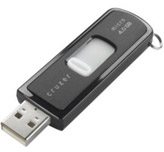 Usually, when your client’s computer won’t boot into the OS the CD drive won’t work. Either a CD will be stuck inside and you can’t eject it, or you can’t insert a new CD as the system won’t recognize it. This is why I always bring a Bootable USB drive with either Snow Leopard of Lion on it. When you insert it in your client’s computer, you can hold the “Option” key (ALT key if you are using a non-Apple keyboard) while you boot the Mac and select your USB drive. To create this USB Key, you need your original Lion installation file or your Snow Leopard CD and use the Disk Utility application on your Mac. (http://www.cultofmac.com/105527/how-to-make-a-bootable-install-disk-of-mac-os-x-lion/)
Usually, when your client’s computer won’t boot into the OS the CD drive won’t work. Either a CD will be stuck inside and you can’t eject it, or you can’t insert a new CD as the system won’t recognize it. This is why I always bring a Bootable USB drive with either Snow Leopard of Lion on it. When you insert it in your client’s computer, you can hold the “Option” key (ALT key if you are using a non-Apple keyboard) while you boot the Mac and select your USB drive. To create this USB Key, you need your original Lion installation file or your Snow Leopard CD and use the Disk Utility application on your Mac. (http://www.cultofmac.com/105527/how-to-make-a-bootable-install-disk-of-mac-os-x-lion/)
 I always bring the Snow Leopard CD. Sometimes you won’t need a USB drive as CD Drive will work just fine. If you install this version on your client’s Mac, you do not need a serial number.
I always bring the Snow Leopard CD. Sometimes you won’t need a USB drive as CD Drive will work just fine. If you install this version on your client’s Mac, you do not need a serial number.
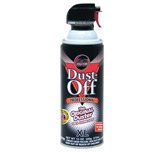 No matter what I do on my client’s computers, I always use the Dust Blower at the end of the job. It adds a professional touch to it and usually the client has never removed the dust. Here in Montreal, I always buy the DustOff Original Duster. You can buy a 10 pack of those for just $12.99.
No matter what I do on my client’s computers, I always use the Dust Blower at the end of the job. It adds a professional touch to it and usually the client has never removed the dust. Here in Montreal, I always buy the DustOff Original Duster. You can buy a 10 pack of those for just $12.99.
Incredible tool that lets you boot in a complete Unix environment directly on the CD. You can access the hard drive and backup files. This is really helpful if the OS does not boot and you want to backup your client’s files. You simply need to insert this CD and an external drive to backup everything. (http://www.knoppix.net/)
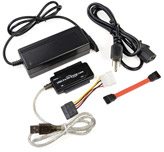 This will let you repair your client hard drive directly from your computer. You remove the hard drive from your client’s computer, plug it into this device, and access it via usb from your machine. This tool is good to repair disk permissions, backup files and to completely clear a hard drive. It works perfectly on both Mac and Pc. You can buy this one here: http://www.ifixit.com/Apple-Parts/Universal-Drive-Adapter/IF107-108
This will let you repair your client hard drive directly from your computer. You remove the hard drive from your client’s computer, plug it into this device, and access it via usb from your machine. This tool is good to repair disk permissions, backup files and to completely clear a hard drive. It works perfectly on both Mac and Pc. You can buy this one here: http://www.ifixit.com/Apple-Parts/Universal-Drive-Adapter/IF107-108
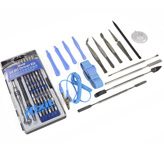 When you try to open your client’s Apple Computer and either change the RAM, remove the hard drive or change the motherboard, you will always have to deal with an unusual screw. Apple does it on purpose so nobody can open/fix their machine except them. You really need to bring all the tools necessary to remove all the pieces for your needs. I use this set of tool created by ifixit: http://www.ifixit.com/Tools/Pro-Tech-Base-Toolkit/IF145-072
When you try to open your client’s Apple Computer and either change the RAM, remove the hard drive or change the motherboard, you will always have to deal with an unusual screw. Apple does it on purpose so nobody can open/fix their machine except them. You really need to bring all the tools necessary to remove all the pieces for your needs. I use this set of tool created by ifixit: http://www.ifixit.com/Tools/Pro-Tech-Base-Toolkit/IF145-072
It has everything you need to repair iMacs, Macbooks, MacPros, iPhone, iPod Touch etc.
Sometimes, when you try to boot the computer and you hear one or two beeps, the RAM failed. I always bring extra RAM to test this issue and to sell it to my clients if this is the problem.
 I bring my pocket 1TB external hard drive for backup. (model no. WDBACZ0010BBK-NESN). Usually your client won’t have another drive to back up his files. I like this HP drive because it is Mac/PC compatible and it supports USB 3.
I bring my pocket 1TB external hard drive for backup. (model no. WDBACZ0010BBK-NESN). Usually your client won’t have another drive to back up his files. I like this HP drive because it is Mac/PC compatible and it supports USB 3.
I bring my 4gb USB key that includes all the free software Mac offers. I always install all of them on my client’s computer. I know this is personal but up until now, my clients love it! This usb key includes:
 The iMac is the most difficult machine in the world to change its hard drive. Why? Because you have to remove the huge front glass. The only way of doing it is with suction cups. I only bring those if my clients have a problem with an iMac. http://www.ifixit.com/Tools/Heavy-duty-Suction-Cups-Pair/IF145-023
The iMac is the most difficult machine in the world to change its hard drive. Why? Because you have to remove the huge front glass. The only way of doing it is with suction cups. I only bring those if my clients have a problem with an iMac. http://www.ifixit.com/Tools/Heavy-duty-Suction-Cups-Pair/IF145-023
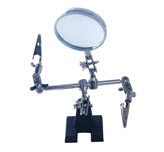 I usually use this on Macbook’s problems. When you have to change the trackpad, keyboard, motherboard etc. http://www.ifixit.com/Tools/Helping-Hands/IF145-082
I usually use this on Macbook’s problems. When you have to change the trackpad, keyboard, motherboard etc. http://www.ifixit.com/Tools/Helping-Hands/IF145-082
 I can easily fit all of those things in this bag. I also always bring my 15” Macbook pro in it. http://www.futureshop.ca/en-CA/product/kensington-contour-pro-17-nylon-laptop-case/10040886.aspx?path=28ee4468307abdf19cb8fdcfbaa5cd56en02
I can easily fit all of those things in this bag. I also always bring my 15” Macbook pro in it. http://www.futureshop.ca/en-CA/product/kensington-contour-pro-17-nylon-laptop-case/10040886.aspx?path=28ee4468307abdf19cb8fdcfbaa5cd56en02
These are my main tools that usually cover everything I need. Whats in your Mac technician bag?
© Technibble – A Resource for Computer Technicians to start or improve their Computer Business
To get started with your own computer business, check out our Computer Business Kit. Inside an Apple Technicians Toolkit
 2 2
2 2
Authors: Bryce Whitty
There is no doubt that social networking is here to stay. While some Computer Technicians may consider it just a new buzz word, other technicians are using it as their primary source of advertising. Google+ is newest major player in the social network game.
After several months, Google finally announced Google+ pages for local businesses, groups, brands and organisations. If you are familiar with Facebook pages, this is basically the Google+ equivalent. In this article, I’ll tell you why you should look into Google+ Pages and what you need to know before you claim your page.
Google+ Pages, like Facebook Pages allows you to have a two way conversation with your clients. If they follow your page, your updates appear in their stream. This is an incredibly cheap way to advertise your business through discounts, specials and generally being on the front of your clients mind.
I know of many Computer Businesses who have already have Google+ accounts for their business. However, it is actually against Google+’s terms to have a Google+ profile for a business. The account must be for an individual. The Google team will suspend accounts that break this rule.
From the Google+ Help Pages:
Your profile and name must represent one individual.
Google+ does not support profiles for couples or groups of people. Additionally, you cannot create a profile for a non-person entity such as a pet or business.Violation examples: Jones Family, Jeremy & Mel Mason, Vegas the Dog, Brooklyn Bagels, Northern California Conservation Society
Google does plan to allow Google+ Business Profiles in time, but don’t hold your breath plus your account could get banned in the mean time.
If you have already done this, you can change your businesses Google+ account back to an individual (typically yourself). You can do this by going to your Google+ profile, click the “Edit Profile” button that is on the top right. Click on the name displayed up the top of the profile page. From there, you can type in a legitimate first name and last name. Then press save.
You may not run contests, sweepstakes, offers, coupons or other such promotions (“Promotion”) directly on your Google+ Page. You may display a link on your Google+ Page to a separate site where your Promotion is hosted so long as you (and not Google) are solely responsible for your Promotion and for compliance with all applicable federal, state and local laws, rules and regulations in the jurisdiction(s) where your Promotion is offered or promoted. Your Promotion must not be run or conducted in a way which conflicts with the +1 Button Policies, Google+ Privacy Policy or Google+ Pages Additional Terms of Service. Google has the right to remove your Promotion content from Google+ Page for any reason.
 When you visit the Create Page link and create a page, the page will be associated with the account that is currently logged in. To access your page from your account, there will be a drop down next to your name saying “1 Page”. Make sure you are logged into the account you want to associate the page with. Unlike Facebook pages, you cannot currently add any additional administrators to your account.
When you visit the Create Page link and create a page, the page will be associated with the account that is currently logged in. To access your page from your account, there will be a drop down next to your name saying “1 Page”. Make sure you are logged into the account you want to associate the page with. Unlike Facebook pages, you cannot currently add any additional administrators to your account.Once you create a G+ page, you will find that its URL is pretty long. For example, Technibbles G+ page URL is: https://plus.google.com/b/111951375001480014041/
Obviously, you don’t want to have write that long URL on any advertising so you can shorten it with a G+ specific URL shortner. I recommend gplus.to
Using gplus.to, I can change Technibbles page URL to http://gplus.to/technibble
© Technibble – A Resource for Computer Technicians to start or improve their Computer Business
To get started with your own computer business, check out our Computer Business Kit. Google+ Pages for Computer Businesses – What You Need To Know